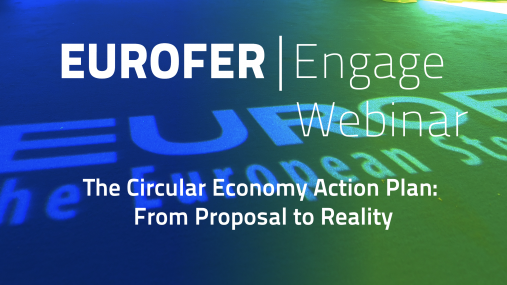
Downloads and links
Download files or visit links related to this content
About steel » Events » EUROFER Engage | Webinar - The Circular Economy Action Plan: from Proposal to Reality
EUROFER Engage | Webinar - The Circular Economy Action Plan: from Proposal to Reality
Countdown
Frequently Asked Questions
Downloads and links
EUROFER's Engage | Webinar - The Circular Economy Action Plan: from Proposal to Reality will take place on 3 February from 10:30 till 11:45.
You can also follow the webinar by visiting this link: https://us02web.zoom.us/j/85789672189
About the webinar
The Circular Economy Action Plan: from Proposal to Reality
In 2020, the EU published a Circular Economy Action Plan. This Action Plan is an important step in developing a truly circular economy in Europe.
This webinar will explore the latest policy changes the EU is planning, and what they mean for the sustainability of products policy, resource efficiency and the EU’s climate change objectives.
As the EU’s circular action plan takes shape, it is more important than ever to identify the right policies to ensure that the right materials are used for the right applications, that they can be recovered, recycled and remanufactured, and that the absolute minimum of waste is produced from the cycle.
EUROFER’s views on how steel can support the circular economy will also be presented – arguing that steel is an excellent example of the circular economy in practice.
When & where?
The webinar will take place on Wednesday, 3 February 2020 from 10:30-11:45 online, via Zoom. Registered participants will receive the link.
Who is invited?
The seminar is open to anyone interested in finding out about EU circular economy policy and the place of the European steel industry in the circular economy.
Schedule
Times are indicative only
10:30 | Presentation
The EU Circular Economy Action Plan, and the example of steel
10:40 | Panel discussion and Q&A
Moderation by Jacki Davis
Building a real circular economy in Europe
11:45 | End of discussion
Thursday, 28 October 2021, starting at 11:00
The webinar will take place online via Zoom. The link will be sent to registered participants in the days before the event takes place.
The webinar is open to anyone interested in the state of the steel market.
This event is free to attend for all participants.
Steel is 100% recyclable – a permanent material that underpins the economy, but also contributes to environmental goals by reducing the use of virgin raw materials and CO2 emissions.
Steel production, use and recycling naturally follows a circular pattern, with steel products returning to the cycle once their service life has ended.
The large volumes of steel produced in Europe every year – 160 million tonnes – are made with large amounts of scrap steel. 56% of EU steel is made from scrap, with around 100 million tonnes of scrap steel recycled every year.
Steel is the world's most important engineering and construction material. It is used in every aspect of our lives; in cars and construction products, refrigerators and washing machines, cargo ships and medical equipment. 85% of a wind turbine is made of steel. The defence industry depends on steel.
Steel is not a single product. There are more than 3,500 different grades of steel with many different physical, chemical, and environmental properties.
Approximately 75% of modern steels have been developed in the past 20 years. If the Eiffel Tower were to be rebuilt today, the new steel types would mean it could be built with one-third of the steel that was originally used. Modern cars are built with new steels that are stronger and up to 35% lighter than in the past.
Steel is a permanent material, the foundation of the circular economy. Steel can be recycled over and over again without loss of properties. It is the most recycled material in the world, more than all other materials combined, with a global recycling rate estimated at between 70% and 90% (EU approx. 88%). An estimated 630 million tonnes of steel scrap are recycled globally every year, saving approximately 950 million tonnes of CO2 emissions.
This webinar will look at what steel is doing to support the circular economy and at the wider implications of EU circular economy policies.